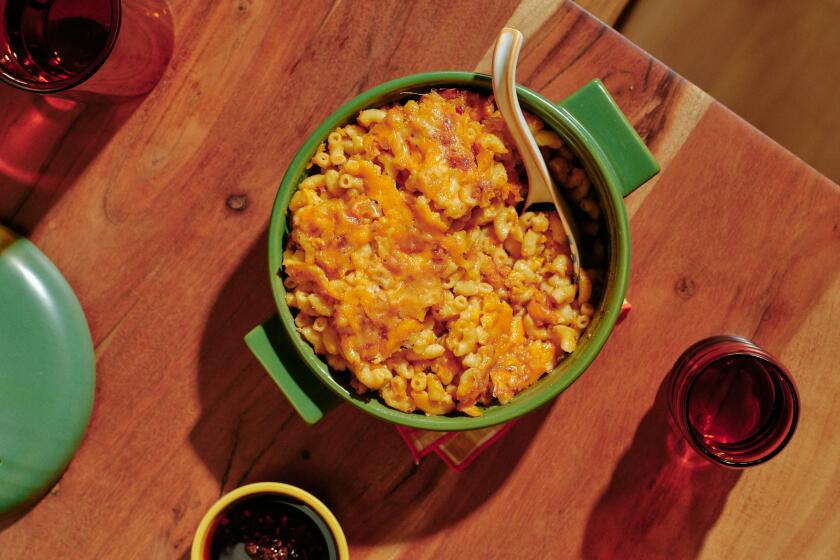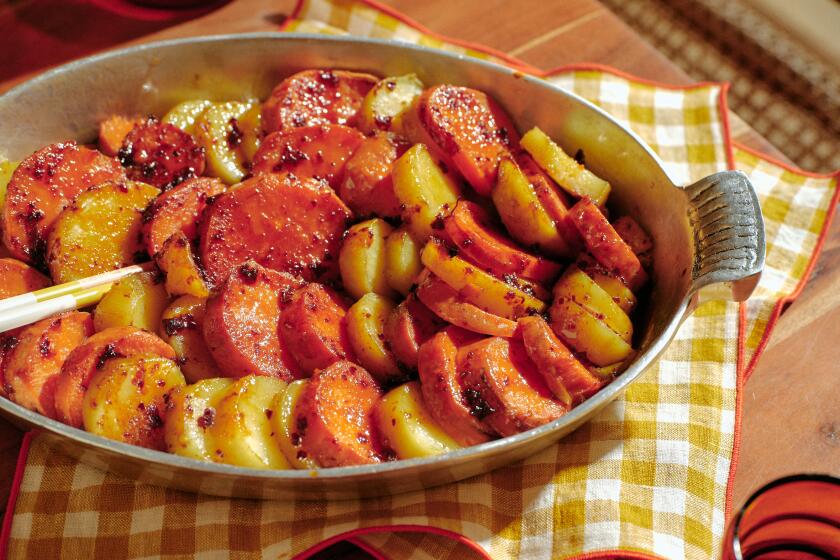Risotto stuffing
Too often, cooks are afraid of risotto, so it gets relegated to special occasions. But a delicious, creamy risotto is easy to make and can take on forms you might never have dreamed of.
Most obvious, perhaps, is using risotto as a bed for braised meats--such as leftover pot roast or short ribs--or even something as simple as sauteed mushrooms.
But that’s only the beginning. A risotto soup can give you a new appreciation for the subtleties of risotto’s flavor, which is often overshadowed by its extraordinary texture. Simply add more liquid at each stage of cooking--keep the rice always swimming in broth, rather than letting it cook dry--and then puree it in a blender, pass it through a fine sieve and garnish it with mushrooms, asparagus or, if you’re feeling clever, a crisp Parmesan tuile .
Go the opposite direction--make it thicker than usual, then grind it into a paste--and it becomes an amazing stuffing for ravioli or other dishes. Perhaps a little plain on its own, it makes a wonderful binder for flavors that otherwise would be too loose for stuffing (mixed with corn juice, it makes a beautiful early fall pasta filling). If you have fresh herbs, add pureed basil or chives or parsley.
Think of risotto the same way you think of mashed potatoes. Thinned with stock and flavored with sauteed leeks, mashed potatoes become potato soup; mixed with some egg, piped out and baked, they become duchess potatoes; rolled into a ball or cylinder, potato croquettes; spread atop a lamb stew, they make the dish a shepherd’s pie. No reason risotto can’t be used in similar ways.
Risotto takes about 25 minutes to cook, but there are shortcuts. In restaurants, risotto is almost always precooked and finished immediately before serving. There’s no reason this can’t be done at home. While it’s not essential, or even ideal, precooking can be helpful when dinner has to be completed quickly at the last minute.
Of course, the first step is making a good basic risotto. Everyone has his own style and taste, but a few critical points make a big difference in the finished result. A classic risotto begins with good medium-grain rice, commonly Arborio, though Carnaroli results in a creamier texture. The best rice usually seems to be packaged in a burlap or cloth bag, not wrapped in plastic.
Using a large saute pan, wilt minced onions in a little olive oil and then add the rice, about a handful per serving. The first critical cooking point is to allow the dry grains of rice to toast in the pan. You’ll know they’re ready when the outside surface appears to be translucent.
Next, add just enough wine to cover and then--critical point two--completely cook off the alcohol (you can tell when this happens because the raw smell will be gone). Add a ladleful of another liquid, usually chicken or vegetable stock, which should be boiling. Bring this back to a simmer. At this point you can finish cooking the risotto in the usual way, but if you’re precooking it, leave it on the heat for just three minutes, then spread the rice thinly on a pan or plate to cool quickly. When cool, cover and refrigerate.
Just before serving, reheat the risotto in more boiling liquid (stock or water), adding it in small increments and stirring continuously with a wooden spoon until the grains begin to release their starch, bind to one another and become tender.
The final step, and the third critical point, is to remove the pan from the heat and beat in the fat, emulsifying it with continuous stirring. The fat should be butter followed by whipped cream, which melts into the risotto and seems to coat the grains more evenly, followed by Parmigiano-Reggiano for the final binding and enriching of the dish. The result should be very creamy, almost like sauced pasta, and slightly loose, losing its shape when spooned onto a plate.
Once you’re comfortable with basic risotto technique (toasting; cooking in small amounts of liquid while stirring continuously; beating in the fat at the end), it’s easy to branch out to other variations. To use risotto as a pasta stuffing, add less liquid during the cooking and finish the dish so that it’s very tight. To make a soup, use more liquid, as described above.
As is so often the case, using ordinary things in different ways is more interesting than simply buying fancy ingredients. Tomatoes become tomato water; the egg becomes a custard; butter melted but kept emulsified becomes a sauce base or a poaching liquid. And risotto becomes soup or stuffing.
Heat the oil in a deep heavy skillet over low heat. Stir in the onion and cook slowly until softened and translucent but not browned, 2 to 3 minutes. Mix in the rice and stir for 3 to 4 minutes until the outer shell of the rice becomes translucent, showing the pearly “eye” at the center.
Add the wine and simmer, without stirring, for 2 to 3 minutes. (After adding the wine, lean close to the pan and breathe the aroma. You will be able to smell the raw alcohol. Breathe in several times during the cooking process, and as the alcohol evaporates and the rice begins to toast, the raw alcohol smell will dissipate and be replaced with the smell of toasted rice.)
When the liquid has been absorbed, stir again to finish toasting the rice. The rice should not brown, but it will separate into individual grains, looking much as it did before the wine was added. Scrape the bottom of the pan to keep the rice from sticking. The alcohol smell should be completely gone. Increase the heat to medium and add just enough stock to cover the rice, and salt to taste. When it boils, reduce the heat and simmer for 4 minutes.
Continue to cook, stirring frequently, letting the rice cook almost completely dry before adding more stock, 1/2 cup at a time. Taste the rice from time to time. The liquid should continue to simmer throughout the cooking process. The finished rice will be similar to al dente pasta; it should be thoroughly cooked but with a little “bite” remaining to it, never mushy. This process should take about 15 minutes. The rice will be drier and “tighter” than risotto normally would be. It should look a bit pasty.
Remove the risotto from the heat and, using a wooden spoon, beat in the butter a little at a time, working quickly so it will emulsify with the rice, creating a creamy risotto. Vigorously beat in the whipped cream, the Parmigiano-Reggiano and salt to taste.
Using a wooden spoon, fold the mascarpone into the risotto; add the basil, chives, parsley and lemon juice to taste, about 1 tablespoon. Adjust the seasoning as necessary. If using for chicken “Kiev,” pass the risotto mixture through a meat grinder with the smallest die attachment, and cool. (If you do not have a meat grinder, you can finely chop the stuffing with a knife.)
Get our Cooking newsletter.
Your roundup of inspiring recipes and kitchen tricks.
You may occasionally receive promotional content from the Los Angeles Times.















